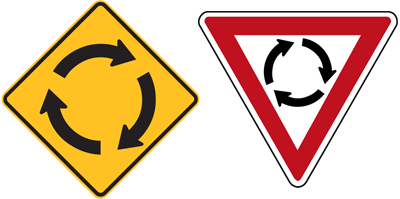A roundabout is a circular intersection or junction in which road traffic flows almost continuously in one direction around a central island. Many intersections have a central roundabout to manage the traffic flow in roads with either a single lane or multiple lanes.
The Roundabout Sign
Roundabouts ahead are marked with a Roundabout sign and can either be single-lane or multi-lane roundabouts.
The roundabout sign means Slow Down, prepare to Give Way and if necessary stop to avoid a collision.
So, as you're approaching a roundabout, you must get into the correct lane, indicate if turning, and give way to traffic already on the roundabout.
Enter the roundabout when there is a safe gap in the traffic.

The sign on the left shows when there is a roundabout ahead. The sign on the right shows when to give way to vehicles on the roundabout.
Signalling
You must indicate for long enough to give sufficient warning to other drivers and pedestrians before entering a roundabout when turning left or right. You must also indicate, if practicable, on exit when going straight ahead. That way, people around you know exactly where you’re headed.
Giving way
Approaching a roundabout: Vehicles entering a roundabout must give way to any vehicle already in the roundabout.
Giving way at a roundabout: means the driver must slow down and if necessary, stop to avoid a collision.
When entering, you must give way to all vehicles, including bicycles, already on the roundabout. So slow down or stop if necessary. Only enter when there is a safe gap.
If you are turning left, begin in the left lane, indicate left on approach and continue to indicate left as you exit the roundabout.
Going left
Slow down and prepare to give way as you approach the roundabout.
On approach you must be in the left lane unless otherwise marked on the road, and indicate a left turn.
You must give way to traffic already on the roundabout if there is any risk of a collision.
Enter the roundabout when there is a safe gap in the traffic.
Stay in the left lane.
Keep your left indicator on until you have exited the roundabout.
If you are turning right, use the right hand lane and indicate right as you approach the roundabout. Indicate left just before you reach your exit.
Going right
Slow down and prepare to give way as you approach the roundabout.
On approach you must be in the right lane unless otherwise marked on the road, and indicate a right turn.
You must give way to traffic already on the roundabout if there is any risk of a collision.
Enter the roundabout when there is a safe gap in the traffic.
Stay in the right lane.
You must indicate a left turn just before your exit unless it is not practical to do so.
If you are going straight ahead, you do not need to indicate on approach, but as you come to your exit, you must indicate left to leave the roundabout
Going straight ahead
Slow down and prepare to give way as you approach the roundabout.
On approach you can be in either lane, unless otherwise marked on road.
When going straight ahead you do not need to indicate on approach.
You must give way to traffic already on the roundabout if there is any risk of collision.
Enter the roundabout when there is a safe gap in the traffic.
You must indicate a left turn just before you exit unless it is not practical to do so.
Note: Do not drive on the central island of a roundabout unless the size of your vehicle means that you cannot avoid the wheels crossing the central kerb.
Traffic signals
Some roundabouts may have traffic lights on an approach. When the signals are operating you may be stopped for a short time by a red light to allow other traffic to access the roundabout. When the signals are not operating or when you proceed after being stopped, you are still to proceed into the roundabout under the normal roundabout rules.
U-turns and exiting
Making a U-turn: When you use the roundabout to make a U-turn on your approach signal right from the right lane, stay in the right lane, but signal left before exiting into the right lane.
Exiting a roundabout: If practical, you must always signal left when exiting a roundabout.
Trucks and buses
Keep an eye on trucks and buses within a roundabout. Due to their size, trucks and buses need more room to turn. They often take up more than one lane and may turn right from the left hand lane. Also their wheels might cross the central kerb when turning. Keep clear of them on roundabouts whenever possible.
Roundabouts and bicycle riders
Bicycle riders are allowed to turn right from the left hand lane. When passing each exit, the rider must give way to any vehicle leaving the roundabout from that exit.
Always keep an eye out for cyclists and consider their needs at roundabouts – they may not be as easily seen as cars. Remember that unlike cars, they are permitted to turn right from the left lane. For safety reasons, cyclists may need to change lanes when approaching, travelling in and leaving roundabouts.
References
http://www.rms.nsw.gov.au/roads/safety-rules/road-rules/roundabouts.html
http://mylicence.sa.gov.au/road-rules/the-drivers-handbook/roundabout
I can help you pass your VORT!